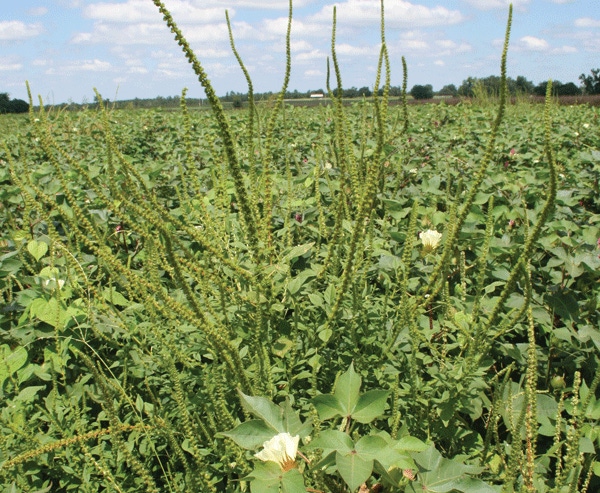
• Resistant pigweed started showing up in north Alabama about a year ago.• 2011 will probably be the key year in maintaining control of the resistant Palmer pigweed scattered across northern Alabama last year.• Growers are being told to be proactive in staying a few steps ahead of these resistant weeds. If they don’t, they could be plowing up fields this year.
January 10, 2011

Farmers in north Alabama’s Tennessee Valley — having yet to receive the full frontal assault from resistant Palmer Amaranth pigweed — have the opportunity to be proactive about battling what has become the major pest of many Southeastern growers.
“We don’t want to see those weeds hauled away in a wagon,” says Charles Burmester, Auburn University Extension agronomist. “It’s better to be proactive on the front end and not have this problem.”
That was the idea behind the “Fighting Roundup-Resistant Horseweed and Pigweed in Northern Alabama” meeting, held this past December in Decatur, Ala. “What I’ve gathered is that next year (2011) will probably be the key year in maintaining control of the resistant Palmer pigweed we found scattered across northern Alabama last year,” Burmester says. “Almost everyone has mentioned they wish they had been more proactive when they first saw the resistance starting.
“The one thing we want to drive home with the conference is the importance of staying proactive — to stay a few steps ahead of these resistant weeds. If we don't, we could very well be plowing up fields this year because we can't control the weeds. We had meetings during the summer with chemical companies and distributors to discuss what we were seeing out in the field, especially with resistant Palmer amaranth, and we talked about what we could do. But the agricultural industry has really pulled together on this thing.”
Burmester says he really started seeing resistant Palmer pigweed in north Alabama fields about a year ago. “We just don’t have much Palmer pigweed in north Alabama, and that’s a good thing because we’ve been able to stay away from the major problems like other areas have had. Last year, I started seeing scattered pigweed in the field, and it looked like Palmer amaranth. We were going in the fields and spraying 2X and 4X rates of Roundup to see if they were resistant. In certain cases, we killed them, and in other cases, we didn’t. So we’re starting to see resistance,” he says.
Heavy concentrations
Burmester says he has seen several strips of heavy concentrations of Palmer amaranth pigweed. It followed the same patterns, he says, as the combine rows from the previous year.
While there’s a definite increase in the number and concentration of resistant Palmer amaranth pigweed in the Tennessee Valley, most of the problems are in spots, he says. “We didn’t see any fields last year that were totally taken by pigweed,” says Burmester.
Some of the worst infestations of pigweed in cotton were following corn, he adds, and corn herbicides are available that will control pigweed.
“If you have a bad field of Palmer pigweed, I’ll probably ask first if you rotate with corn. Many growers cut corn in August and early September, and then harvest soybeans and forget about the corn. What happens is you’re just growing a good crop of weed seed. I saw a lot of corn fields and early soybean fields where the weeds came up later,” he says.
Auburn University researchers have found that teaweed is a better host of reniform nematodes than cotton or soybeans, says Burmester. “If you let teaweed — or iron weed — grow in the winter or fall, you’re probably producing several generations of reniform nematodes. There’s more than one reason for controlling some of these winter weeds.”
Growers in the Tennessee Valley have dealt with horseweed for awhile now, he says. “It just seems to be getting worse and worse each year. We first began seeing resistant horseweed here about five years ago. All we had to do for awhile was put a little Clarity in with our Roundup and it took care of the problem, but things are changing.”
In some cases, says Burmester, growers are using Valor to get residual control.
“The physiology of this weed has changed. It used to be a winter weed. Now it seems to come up at anytime of the year. But if you get good control early, and you think you’ve got it made, you can still get good flushes of horseweed coming up later in the year.”
Another weed control issue facing growers in north Alabama is whether or not they’ll be able to use flumetron or Cotoran next year. “Cotoran is a herbicide we’ve used for many years in cotton. Our cotton acres have decreased somewhat in recent years, but with current prices, it may make a comeback this next season. We found out last year that Cotoran is no longer labeled for use in Madison, Limestone, Lawrence, Colbert and Tuscaloosa counties in Alabama. This was based on groundwater data taken in the late 1990s and early 2000s.
“We’ve had some meetings on this, and all I can say now is that I really don’t think things are going to change. We weren’t using enough Cotoran to make it feasible for the company to do research and get those counties back on the label.”
About the Author(s)
You May Also Like



